Buckminster Fuller's Dymaxion world map redesigned
News: a map that illustrates global forest densities using wood textures has won a competition to reinvent the tessellated world map designed 70 years ago by American architect and visionary designer R. Buckminster Fuller (+ slideshow).
First presented in 1943, Fuller's Dymaxion Map projects the world map onto the surface of a three-dimensional icosahedron that can be unfolded and flattened to two dimensions. It is said to be the first two-dimensional map of the entire surface of Earth that reveals our planet as one, without inaccurately distorting or splitting up the land.
A team comprising designer Nicole Santucci and San Francisco firm Woodcut Maps was selected as the winner of the Dymax Redux competition to redesign the seminal map, which was launched in April by the Buckminster Fuller Institute (BFI) in New York to coincide with the map's 70th anniversary.
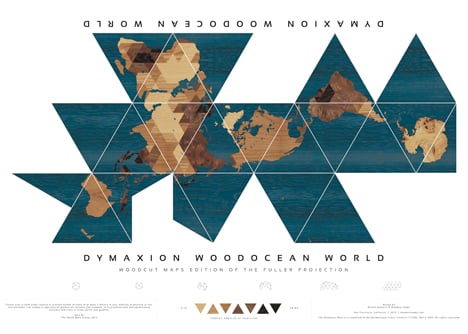
The winning design, called Dymaxion Woodocean World, illustrates forest densities across the world through the use of different coloured wood textures. Darker wood refers to a higher ratio of trees to land space.
"Nicole Santucci and team created a wonderful display of global forest densities, an ever-increasing important issue with the continued abuses of deforestation," said the BFI. "What's more an actual woodcut version of the map was made in the process, allowing the 2D version to transform into an icosahedral globe," the institute added.
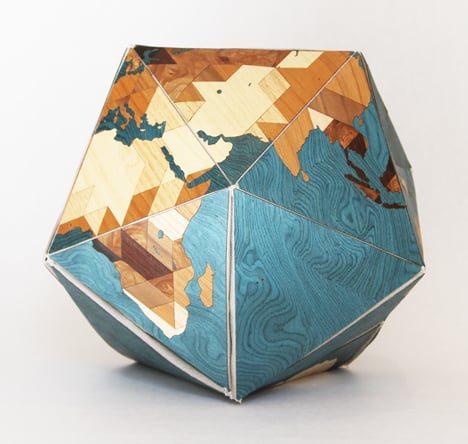
Will Elkins, manager at the Buckminster Fuller Institute said: "They went above and beyond our call by creating a powerful display of relevant information using the subject matter itself as a medium. The idea, craftsmanship and end result are stunning."

A hand-drawn map of clouds swirling over the earth by French designer Anne-Gaelle Amiot has been selected as the runner-up.
Other finalists include a map that illustrates 75,000 years of ancestral migration and another that shows the availability of safe drinking water around the world. Three of the 11 finalists also received acknowledgments from graphic designer Nicholas Felton, artist Mary Mattingly and architect and close friend of Fuller, Shoji Sadao.
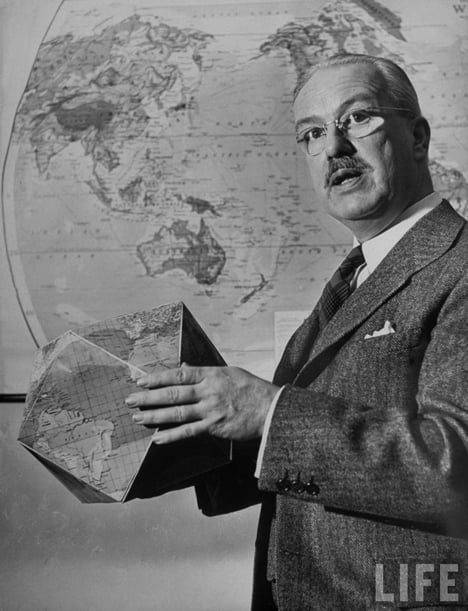
Fuller's Dymaxion World Map first appeared in the March 1, 1943 issue of Life Magazine in an article titled 'Buckminster Fuller's Dymaxion World'.
The article illustrated different uses for the map and included a full-colour printable version with instructions for how it can be easily transformed from a 2D map to a 3D globe.
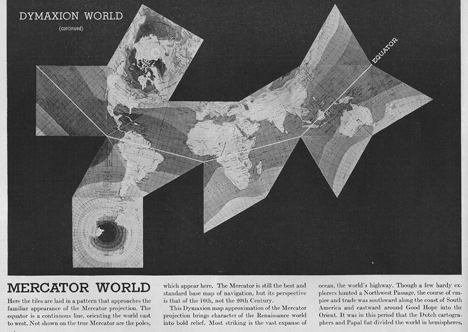
"Fuller's Dymaxion World embodies his effort to resolve the dilemma of cartography: how to depict as a flat surface this spherical world, with true scale, true direction and correct configuration at one and the same time," wrote Life Magazine in 1943.
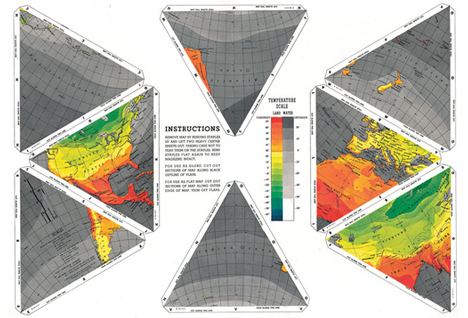
Fuller designed the map as a way to visualise the whole planet with greater accuracy and to in turn better equip humans to address global challenges.
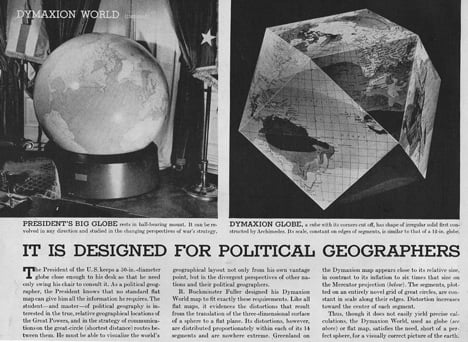
The winners and nine finalists of the Dymax Redux contest will be exhibited at the Cooper Union for the Advancement of Science and Art in New York later this year. The Dymaxion Woodocean Map will be available to buy from the BFI soon.
See other features related to Buckminster Fuller »
See more maps on Dezeen »
See more graphic design »
Here's the announcement from BFI, including full details of the winning designs:
DYMAX REDUX Winner Selected
The Buckminster Fuller Institute is happy to announce the winner of DYMAX REDUX, an open call to create a new and inspiring interpretation of Buckminster Fuller's Dymaxion Map. Dymaxion Wood Ocean World by Nicole Santucci of Woodcut Maps (San Francisco, CA) has been selected as the winner out of a pool of over 300 entrants from 42 countries. Clouds Dymaxion Map by Anne-Gaelle Amiot of France was selected as the runner up.
"This was the first contest of its kind organised by BFI, and the response and interest has been amazing. We are thrilled to have such a high level of submissions and look forward to doing more similar initiatives in the future" says BFI Executive Director Elizabeth Thompson, noting the great press coverage to-date.
The Buckminster Fuller Institute will produce the winning entry as a poster and include it in with the BFI online educational resource store. In addition, we have highlighted three entries that were chosen by our guest critics - Nicholas Felton, Mary Mattingly and Shoji Sadao - as their favourite individual picks. The winner and runner-up along with the other nine finalists will be featured at an in-person exhibition at the Cooper Union for the Advancement of Science and Art, scheduled for later this fall.
The Winner: Dymaxion Woodocean World by Nicole Santucci + Woodcut Maps, United States
Nicole Santucci and team created a wonderful display of global forest densities, an ever-increasing important issue with the continued abuses of deforestation. What's more an actual woodcut version of the map was made in the process, allowing the 2-D version to transform into an icosahedral globe. As BFI Store Coordinator Will Elkins put it "They went above and beyond our call by creating a powerful display of relevant information using the subject matter itself as a medium. The idea, craftsmanship and end result are stunning."
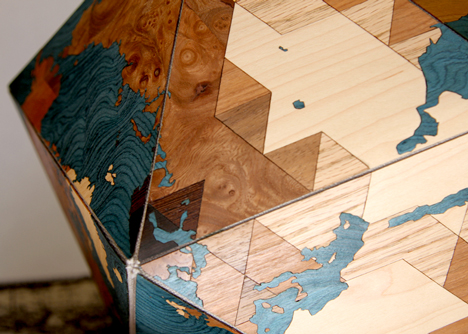
The Runner-Up: Clouds Dymaxion Map by Anne-Gaelle Amiot, France
Anne-Gaelle Amiot used NASA satellite imagery to create this absolutely beautiful hand-drawn depiction of a reality that is almost always edited from our maps: cloud patterns circling above Earth. Anne-Gaelle describes the idea and process "One of the particularism of Buckminster Fuller's Dymaxion projection is to give the vision of an unified world. From the space, the Earth appears to us covered, englobed by the cloud masses which circulate around it. By drawing a static image, capture of clouds position in one particular moment, the sensation of a whole is created. The result have the aspect of an abstract pattern, a huge melt where it is impossible to dissociate lands, seas, oceans."
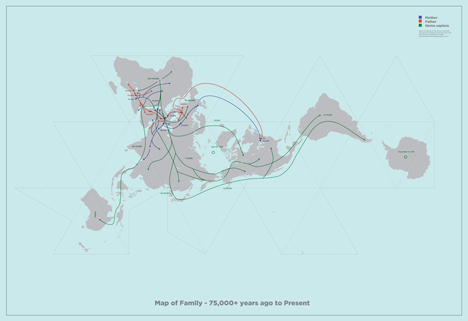
Nicholas Felton Pick: Map of My Family by Geoff Christou, Canada
"This map makes the best use of the Dymaxion projection, by highlighting information that is primarily land-based and allowing for the paths to extend in an unbroken fashion throughout the world." - Nicholas Felton
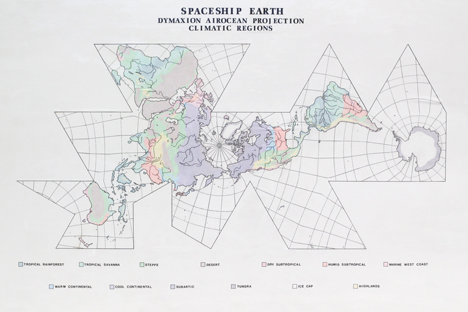
Mary Mattingly Pick: Spaceship Earth: Climatic Regions by Ray Simpson, United States
"Eliminates human-made borders and focuses on mapping the shifting yet distinct climactic planes. This utopian projection relies only on geographic and geologic borders, truly a project Buckminster Fuller would appreciate." - Mary Mattingly
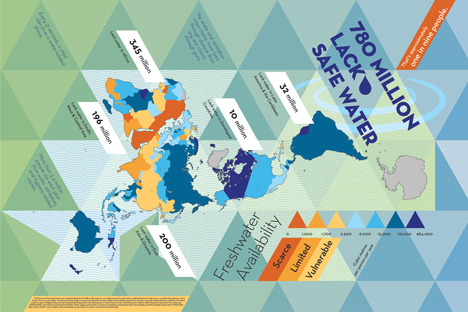
Shoji Sadao Pick: In Deep Water by Amanda R. Johnson, United States
"A dramatic graphic take off on the map and gives important information about one of the basic problems that needs to be solved." - Shoji Sadao
About DYMAX REDUX:
70 years ago Life magazine published Buckminster Fuller’s Dymaxion Map. With an undistorted projection of the Earth’s surface, ability to be easily reconfigured and transform from a 2-D map to a 3-D globe, the Dymaxion Map (patented in 1946) was a cartographic breakthrough and its iconic design has inspired generations since.
In celebration of the map's publication anniversary, the Buckminster Fuller Institute (BFI) is calling on today’s graphic designers, visual artists, and citizen cartographers to create a new and inspiring interpretation of the Dymaxion Map. BFI will publish notable entries within an online gallery, feature the selected finalists in a gallery exhibition in New York City and select one winning entry to be produced as a 36" x 24" poster and offered for sale within our online store.
BFI is seeking submissions across the creative spectrum and will be selecting the winner based on originality, aesthetic beauty and informative qualities. The contest is open to all and will provide entrants with a high-res image to use as ‘canvas’. Submissions must employ or contain obvious reference to the map’s foundational grid and adhere to specific size and resolution requirements.
About the Buckminster Fuller Institute
The Buckminster Fuller Institute is dedicated to accelerating the development and deployment of solutions which radically advance human well being and the health of our planet's ecosystems. We aim to deeply influence the ascendance of a new generation of design-science pioneers who are leading the creation of an abundant and restorative world economy that benefits all humanity.
Our programs combine unique insight into global trends and local needs with a comprehensive approach to design. We encourage participants to conceive and apply transformative strategies based on a crucial synthesis of whole systems thinking, Nature's fundamental principles, and an ethically driven worldview.
By facilitating convergence across the disciplines of art, science, design and technology, our work extends the profoundly relevant legacy of R. Buckminster Fuller. In this way, we strive to catalyse the collective intelligence required to fully address the unprecedented challenges before us.